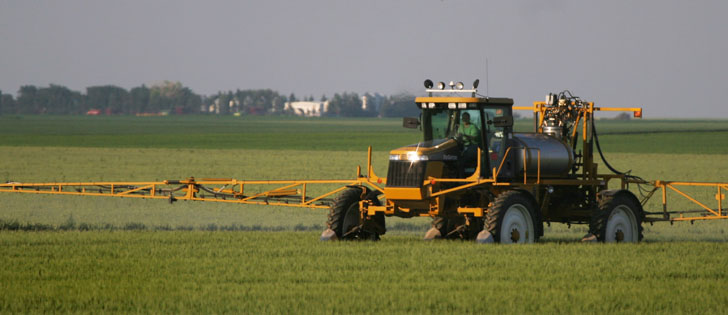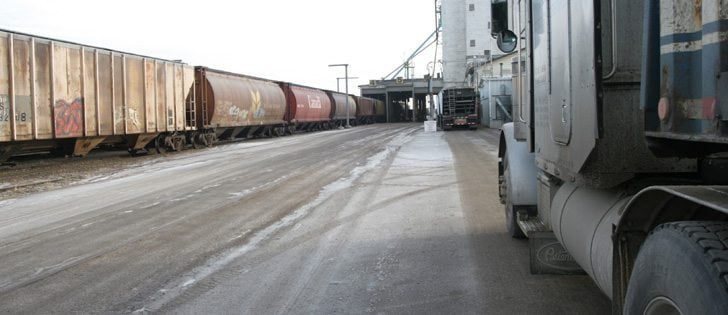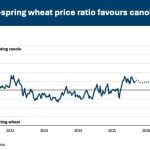Economic analysts continue to see little but blue skies and profits for farmers this year, even if risks are growing slowly beneath the surface.
In an agricultural industry outlook session April 26, two senior lenders from the Bank of Montreal and Canadian Federation of Agriculture president Ron Bonnett sketched a picture of farmers continuing to recover from previous decades of low prices and reinvesting in their farms.
There is “a lot of optimism, and that optimism is well-founded,” said Ross Purdy, manager of farm lending for BMO in Alberta.
Read Also

Farmers urged to be grain-safe this fall
Working around grain bins comes with risk, from farmers falling to drowning in grain: Experts have five tips to help avoid grain-related accidents this harvest.
BMO national agricultural lending manager David Rinneard said his bank’s just-released outlook analysis report suggests that good financial times will continue this year for farmers who are able to produce crops and livestock.
“Overall, 2012 should be a prosperous year for agriculture, and certainly we see this prosperity manifesting itself in sound financial returns,” said Rinneard.
Bonnett agreed that farmers are optimistic and said he shared the outlook.
“I think we’re well-positioned to take advantage of some of the market opportunities out there,” said Bonnett.
The BMO outlook is not one of unrestrained bullishness. It expects prices for most farm commodities to moderate, although they will “remain at elevated levels.” That applies to crops and livestock.
However, a rising loonie and input prices will reduce farm profits from what they could be.
Bonnett and the lenders recommended farmers take risk management seriously to avoid dangers and protect profits. Purdy said some cattle feeders are now suffering from recent declining fed cattle prices and strong feedgrain prices, but hedged producers have continued to do well.
“A good number of our cattle feeders placed hedge positions or forward delivery contracts last fall on cattle that are marketed now,” said Purdy.
“They are sharing really good returns by having that method.”
Interest rate changes are also a possible threat to margins, with Bank of Canada governor Mark Carney recently suggesting higher interest rates could be coming.
Rinneard said farmers should do “sensitivity analyses” on their farm finances to see what would happen if interest rates increased from today’s historically low levels. A mix of fixed rate financing and variable rates allows farmers more security than solely using variable rates, which are attractive now because of the low rates.
“Regardless of what the prevailing rate at the time is, you’ve got a partial hedge in place to address what will be an inevitable interest rate increase,” said Rinneard.
He noted that a one percent interest rate increase on the farm sector’s $70 billion in debt would equal $700 million in increased financing costs, all of which would come out of farm returns.
However, BMO does not expect higher interest rates soon.
“I don’t believe our economists are really anticipating a material in-crease in interest rates.”
Money has been pouring into agriculture around the world for the past decade as outlooks for continued high ag commodity prices offer the prospect of continuing profitability.
Hedge fund money has flowed into direct purchases of farmland, investors are bidding up the share prices of farm equipment manufacturers and investors have piled into agricultural futures contracts.
BMO has made a strong move into the agricultural lending area in recent years, which the big banks often avoid because of the role that Farm Credit Canada plays.
BMO has issued reports on agriculture and held panel discussions about them, such as the one held last week, often with the participation of the CFA.
Rinneard said his bank’s portfolio of agricultural lending has increased more than its overall portfolio in recent years, which shows its interest in the often-neglected area of the national economy.
Rinneard said farming and agriculture’s contribution to the economy is underappreciated and that many industries depend on it.
“Farms are very capital intensive businesses and when they are prosperous, they are investing in infrastructure and other capital investments” such as machinery.
Bonnett said the recent years of profitability have allowed farmers to recover from many years of low returns or losses, and most of them have plowed their profits back into improving their farms.
“As farmers get more profit, they then reinvest in machinery and equipment and that immediately begins reflecting in productivity increases,” said Bonnett.
Of course, crop production de-pends on weather, and Rinneard said overall agricultural returns for the past two years have been hurt by bad weather conditions in Western Canada.
“It really contracted,” Rinneard said.















